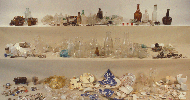
Campus Heritage: You Are What You Trash
Today, in the electronic age, we have innumerable forms of social media to leave behind our personal legacies, for better or worse. Prior to that, folks used photographs, letters, diaries, and…archaeology (only they didn’t know it at the time). Nowadays, most of us don’t think about our waste or where it goes. Recyclables in one bin, rubbish in the other, and there it goes every week to the big communal landfill. But municipal waste service hasn’t always been around. In the city of Santa Clara, for example, city garbage service didn’t start until the 1940’s, so prior to that people had to find other ways to dispose of their trash. The most common way was to dump or bury it at the back in your yard, along the rear fence line (most properties were bigger back then). Most families also had a “burn barrel,” used outdoor privies or pits to put garbage in, or hauled off wagonloads of waste to be dumped, usually in a ravine.
The concept of trash recycling has grown incrementally in the past few decades, but back then it was not given any consideration. Anything could be dumped into the family trash pile, and it was. If it couldn’t be reused, fixed, or given to someone else, there it went. Archaeologists consider these “time capsules” an irreplaceable source of intimate information about the communities they study. All manner of glass bottles (foodstuffs, liquor, medicines, flavorings, oils, solvents, etc.), metal (machinery, broken toys, tools, wires, carriages, car parts, household items, etc.), food bones, textiles, ceramics (broken dishes, condiments, crockery, plumbing fixtures, etc.) were tossed into the pile.
Using this information, along with historic maps, photographs and old city directories, we can figure out the names of families, their professions, and quite often, their social standing, by the nature and quality of their wares. For example, archaeological studies are currently underway on the city block containing the new Franklin Parking Garage and Art and Art History building. From the 1860’s-1930’s, this was a residential block of largely German families. Their refuse pits indicate that children were present (doll parts, marbles, cap guns, a sheriff’s badge cut out from a can, slate chalkboards, and even a note in a bottle), and, in one household, an invalid was taken care of for a long period of time. Still another household had a pretty hefty preference for a certain type of gin, and another had a right-handed cook. At least two catastrophic events were evident: an earthquake (probably the 1906) and a house abandonment (probably in conjunction with a death) in the 1930’s. We are in the process of researching the Santa Clara City directories, and will soon have names of the former residents for the parcels containing these trash pits.
In this specific sense, archaeology can almost be considered as the “social media” of yore. Everything about your trash, good or bad, whether it represents your most regrettable moment or highest achievement, is an open book to archaeologists.
Contributed by Linda Hylkema, Cultural Resources Manager/Campus Archaeologist